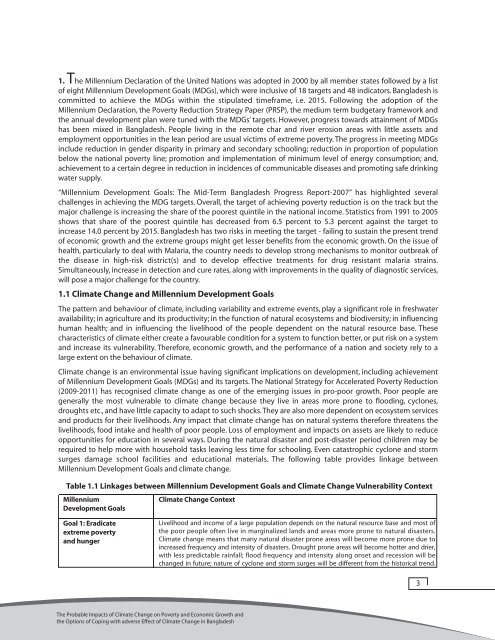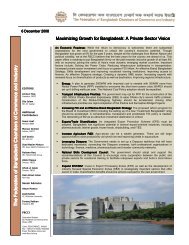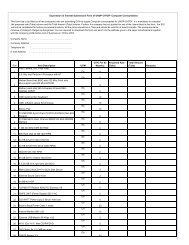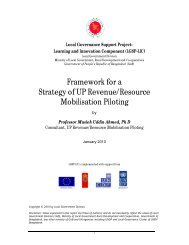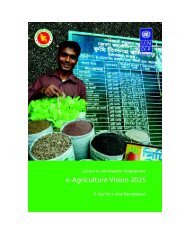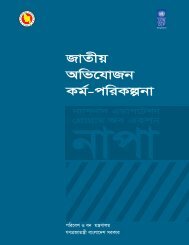The probable impacts of climate change on poverty - UNDP
The probable impacts of climate change on poverty - UNDP
The probable impacts of climate change on poverty - UNDP
Create successful ePaper yourself
Turn your PDF publications into a flip-book with our unique Google optimized e-Paper software.
1. <str<strong>on</strong>g>The</str<strong>on</strong>g> Millennium Declarati<strong>on</strong> <str<strong>on</strong>g>of</str<strong>on</strong>g> the United Nati<strong>on</strong>s was adopted in 2000 by all member states followed by a list<br />
<str<strong>on</strong>g>of</str<strong>on</strong>g> eight Millennium Development Goals (MDGs), which were inclusive <str<strong>on</strong>g>of</str<strong>on</strong>g> 18 targets and 48 indicators. Bangladesh is<br />
committed to achieve the MDGs within the stipulated timeframe, i.e. 2015. Following the adopti<strong>on</strong> <str<strong>on</strong>g>of</str<strong>on</strong>g> the<br />
Millennium Declarati<strong>on</strong>, the Poverty Reducti<strong>on</strong> Strategy Paper (PRSP), the medium term budgetary framework and<br />
the annual development plan were tuned with the MDGs’ targets. However, progress towards attainment <str<strong>on</strong>g>of</str<strong>on</strong>g> MDGs<br />
has been mixed in Bangladesh. People living in the remote char and river erosi<strong>on</strong> areas with little assets and<br />
employment opportunities in the lean period are usual victims <str<strong>on</strong>g>of</str<strong>on</strong>g> extreme <strong>poverty</strong>. <str<strong>on</strong>g>The</str<strong>on</strong>g> progress in meeting MDGs<br />
include reducti<strong>on</strong> in gender disparity in primary and sec<strong>on</strong>dary schooling; reducti<strong>on</strong> in proporti<strong>on</strong> <str<strong>on</strong>g>of</str<strong>on</strong>g> populati<strong>on</strong><br />
below the nati<strong>on</strong>al <strong>poverty</strong> line; promoti<strong>on</strong> and implementati<strong>on</strong> <str<strong>on</strong>g>of</str<strong>on</strong>g> minimum level <str<strong>on</strong>g>of</str<strong>on</strong>g> energy c<strong>on</strong>sumpti<strong>on</strong>; and,<br />
achievement to a certain degree in reducti<strong>on</strong> in incidences <str<strong>on</strong>g>of</str<strong>on</strong>g> communicable diseases and promoting safe drinking<br />
water supply.<br />
“Millennium Development Goals: <str<strong>on</strong>g>The</str<strong>on</strong>g> Mid-Term Bangladesh Progress Report-2007” has highlighted several<br />
challenges in achieving the MDG targets. Overall, the target <str<strong>on</strong>g>of</str<strong>on</strong>g> achieving <strong>poverty</strong> reducti<strong>on</strong> is <strong>on</strong> the track but the<br />
major challenge is increasing the share <str<strong>on</strong>g>of</str<strong>on</strong>g> the poorest quintile in the nati<strong>on</strong>al income. Statistics from 1991 to 2005<br />
shows that share <str<strong>on</strong>g>of</str<strong>on</strong>g> the poorest quintile has decreased from 6.5 percent to 5.3 percent against the target to<br />
increase 14.0 percent by 2015. Bangladesh has two risks in meeting the target - failing to sustain the present trend<br />
<str<strong>on</strong>g>of</str<strong>on</strong>g> ec<strong>on</strong>omic growth and the extreme groups might get lesser benefits from the ec<strong>on</strong>omic growth. On the issue <str<strong>on</strong>g>of</str<strong>on</strong>g><br />
health, particularly to deal with Malaria, the country needs to develop str<strong>on</strong>g mechanisms to m<strong>on</strong>itor outbreak <str<strong>on</strong>g>of</str<strong>on</strong>g><br />
the disease in high-risk district(s) and to develop effective treatments for drug resistant malaria strains.<br />
Simultaneously, increase in detecti<strong>on</strong> and cure rates, al<strong>on</strong>g with improvements in the quality <str<strong>on</strong>g>of</str<strong>on</strong>g> diagnostic services,<br />
will pose a major challenge for the country.<br />
1.1 Climate Change and Millennium Development Goals<br />
<str<strong>on</strong>g>The</str<strong>on</strong>g> pattern and behaviour <str<strong>on</strong>g>of</str<strong>on</strong>g> <str<strong>on</strong>g>climate</str<strong>on</strong>g>, including variability and extreme events, play a significant role in freshwater<br />
availability; in agriculture and its productivity; in the functi<strong>on</strong> <str<strong>on</strong>g>of</str<strong>on</strong>g> natural ecosystems and biodiversity; in influencing<br />
human health; and in influencing the livelihood <str<strong>on</strong>g>of</str<strong>on</strong>g> the people dependent <strong>on</strong> the natural resource base. <str<strong>on</strong>g>The</str<strong>on</strong>g>se<br />
characteristics <str<strong>on</strong>g>of</str<strong>on</strong>g> <str<strong>on</strong>g>climate</str<strong>on</strong>g> either create a favourable c<strong>on</strong>diti<strong>on</strong> for a system to functi<strong>on</strong> better, or put risk <strong>on</strong> a system<br />
and increase its vulnerability. <str<strong>on</strong>g>The</str<strong>on</strong>g>refore, ec<strong>on</strong>omic growth, and the performance <str<strong>on</strong>g>of</str<strong>on</strong>g> a nati<strong>on</strong> and society rely to a<br />
large extent <strong>on</strong> the behaviour <str<strong>on</strong>g>of</str<strong>on</strong>g> <str<strong>on</strong>g>climate</str<strong>on</strong>g>.<br />
Climate <str<strong>on</strong>g>change</str<strong>on</strong>g> is an envir<strong>on</strong>mental issue having significant implicati<strong>on</strong>s <strong>on</strong> development, including achievement<br />
<str<strong>on</strong>g>of</str<strong>on</strong>g> Millennium Development Goals (MDGs) and its targets. <str<strong>on</strong>g>The</str<strong>on</strong>g> Nati<strong>on</strong>al Strategy for Accelerated Poverty Reducti<strong>on</strong><br />
(2009-2011) has recognised <str<strong>on</strong>g>climate</str<strong>on</strong>g> <str<strong>on</strong>g>change</str<strong>on</strong>g> as <strong>on</strong>e <str<strong>on</strong>g>of</str<strong>on</strong>g> the emerging issues in pro-poor growth. Poor people are<br />
generally the most vulnerable to <str<strong>on</strong>g>climate</str<strong>on</strong>g> <str<strong>on</strong>g>change</str<strong>on</strong>g> because they live in areas more pr<strong>on</strong>e to flooding, cycl<strong>on</strong>es,<br />
droughts etc., and have little capacity to adapt to such shocks. <str<strong>on</strong>g>The</str<strong>on</strong>g>y are also more dependent <strong>on</strong> ecosystem services<br />
and products for their livelihoods. Any impact that <str<strong>on</strong>g>climate</str<strong>on</strong>g> <str<strong>on</strong>g>change</str<strong>on</strong>g> has <strong>on</strong> natural systems therefore threatens the<br />
livelihoods, food intake and health <str<strong>on</strong>g>of</str<strong>on</strong>g> poor people. Loss <str<strong>on</strong>g>of</str<strong>on</strong>g> employment and <str<strong>on</strong>g>impacts</str<strong>on</strong>g> <strong>on</strong> assets are likely to reduce<br />
opportunities for educati<strong>on</strong> in several ways. During the natural disaster and post-disaster period children may be<br />
required to help more with household tasks leaving less time for schooling. Even catastrophic cycl<strong>on</strong>e and storm<br />
surges damage school facilities and educati<strong>on</strong>al materials. <str<strong>on</strong>g>The</str<strong>on</strong>g> following table provides linkage between<br />
Millennium Development Goals and <str<strong>on</strong>g>climate</str<strong>on</strong>g> <str<strong>on</strong>g>change</str<strong>on</strong>g>.<br />
Table 1.1 Linkages between Millennium Development Goals and Climate Change Vulnerability C<strong>on</strong>text<br />
Millennium<br />
Development Goals<br />
Goal 1: Eradicate<br />
extreme <strong>poverty</strong><br />
and hunger<br />
Climate Change C<strong>on</strong>text<br />
<str<strong>on</strong>g>The</str<strong>on</strong>g> Probable Impacts <str<strong>on</strong>g>of</str<strong>on</strong>g> Climate Change <strong>on</strong> Poverty and Ec<strong>on</strong>omic Growth and<br />
the Opti<strong>on</strong>s <str<strong>on</strong>g>of</str<strong>on</strong>g> Coping with adverse Effect <str<strong>on</strong>g>of</str<strong>on</strong>g> Climate Change in Bangladesh<br />
Livelihood and income <str<strong>on</strong>g>of</str<strong>on</strong>g> a large populati<strong>on</strong> depends <strong>on</strong> the natural resource base and most <str<strong>on</strong>g>of</str<strong>on</strong>g><br />
the poor people <str<strong>on</strong>g>of</str<strong>on</strong>g>ten live in marginalized lands and areas more pr<strong>on</strong>e to natural disasters.<br />
Climate <str<strong>on</strong>g>change</str<strong>on</strong>g> means that many natural disaster pr<strong>on</strong>e areas will become more pr<strong>on</strong>e due to<br />
increased frequency and intensity <str<strong>on</strong>g>of</str<strong>on</strong>g> disasters. Drought pr<strong>on</strong>e areas will become hotter and drier,<br />
with less predictable rainfall; flood frequency and intensity al<strong>on</strong>g <strong>on</strong>set and recessi<strong>on</strong> will be<br />
<str<strong>on</strong>g>change</str<strong>on</strong>g>d in future; nature <str<strong>on</strong>g>of</str<strong>on</strong>g> cycl<strong>on</strong>e and storm surges will be different from the historical trend.<br />
3


